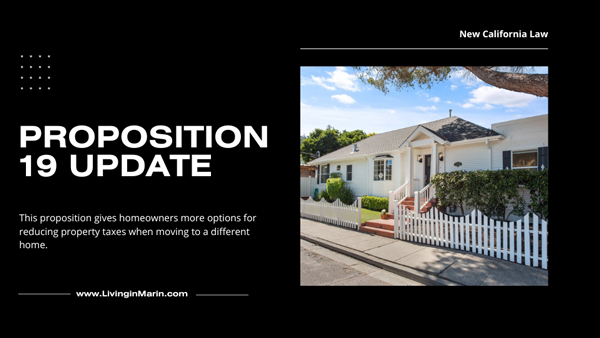Proposition 19 allows eligible homeowners to transfer the taxable value of their existing primary residence to a replacement primary residence. The new law, replacing Propositions 60 and 90 on April 1, 2021, gives homeowners more options for moving to a different home for their retirement years. If you are 55 years old or older and meet the requirements of the law, you can apply your existing tax bill to a replacement home. You may be able to reduce tour property taxes to half or less!
Conditions
- One owner of the original property must be 55 or over.
- The transfer of taxable value can be filed up to three times by a property owner over their lifetime. Each transfer can use the Factored Base Value (see below) of the first home sold.
- The transfer may be within two years of sale of original primary residence. The sale price of this house becomes the full cash value* of the original primary residence.
- The replacement residence can be of any value, and and the transfer can be anywhere within the state; all counties are included.
- If the replacement residence is of equal or lesser value than the original primary residence, the factored base year value** of the original primary residence may be transferred to the replacement residence.
- If the replacement residence is of greater value than the original primary residence, partial relief is available. The new base year value of the replacement residence is the sum of the factored base year value** of the original primary residence plus the difference between the full cash values* of the original primary residence and the replacement residence.
- To qualify for this exclusion, the owner is required to live in the replacement property and must have a Homeowners’ Exemption filed within one year of the transfer.
*Full Cash Value
The full cash value of the original and replacement properties are the sale prices reported to the county assessor. In comparing the full cash vales, Proposition 19 allows a 5% or 10% adjustment depending on the purchase date of the replacement residence:
100% of the amount of the full cash value of the original primary residence if the replacement primary residence is purchased or newly constructed before the sale date of the original primary residence.
105% of the amount of the full cash value of the original primary residence if the replacement primary residence is purchased or newly constructed within the first year following the sale date of the original primary residence.
110% of the amount of the full cash value of the original primary residence if the replacement primary residence is purchased or newly constructed within the second year following the sale date of the original primary residence.
**Factored Base Year Value
The base year value is the market value as of 1975 or as established when the property last changed ownership or was modified due to construction. This amount is then increased by the county assessor by no more than 2% each year. The increased base year value is the factored base year value (FBYV). You can find the FBYV on your recent property tax notice (listed as Total Assessed Value). If you know your parcel number or Tax ID, you can look up your Total Assessed Value on the assessor’s web site. The Total Assessed Value may be reduced up to $7,000 if you filed a homeowner exemption on your property, to produce the Net Assessed Value.
Examples
These examples show the savings in property taxes if the price of your replacement home is higher than the value of your original home.
- Original house sold for $1M.
- Replacement house purchased for $1M
- Difference: 0
- Factored base year value of original house: $325,000
- New base year value of replacement house: $325,000
- Annual property tax on $1M at 1.25% = $12,500 (without Prop. 19)
- Annual property tax on $325,000 at 1.25% = $4,063 (with Prop. 19)
- Savings: $8,438 per year
- Original house sold for $1M.
- Replacement house purchased for $1.2M
- Difference: $200,000
- Factored base year value of original house: $325,000
- New base year value of replacement house: $325,000 + $200,000 = $525,000
- Annual property tax on $1.2M at 1.25% = $15,000 (without Prop. 19)
- Annual property tax on $525,000 at 1.25% = $6,563 (with Prop. 19)
- Savings: $15,000 – $6,563 = $8,437 per year
- Original house sold for $1M.
- Replacement house purchased for $1.5M
- Difference: $500,000
- Factored base year value of original house: $325,000
- New base year value of replacement house: $325,000 + $500,000 = $825,000
- Annual property tax on $1,500,000 at 1.25% = $18,750 (without Prop. 19)
- Annual property tax on $825,000 at 1.25% = $10,313 (with Prop. 19)
- Savings: $18,750- $10,313 = $8,437 per year
You can see that the property tax in these examples increases from $4,063 to $10,313 per year as the cost of a replacement house exceeds the value of an original house. However, Prop. 19 still provides a saving of $8,437 per year for a more expensive house.
Questions about Proposition 19
The California legislature and the State Board of Equalization have addressed many questions concerning Proposition 19; for example:
- How to evaluate factored base year value of new construction or part of multi-unit property.
- Dealing with co-owners.
- Dealing with gifted properties.
- Dealing with mobile homes.
For answers to your questions, refer to the Letters to Assessors or contact the Property Tax Department by phone or email.
NOTE: Please consult the your tax advisor. Madeline Schaider Real Estate is not a tax advisor.
Special Circumstances
Natural disasters: In cases of homes destroyed by wildfires or other natural disasters, Prop. 19 allows homeowners to purchase a replacement home of greater value than their original home and transfer their tax base with an adjustment to account for the value difference.
Severely disabled persons: Qualified persons can transfer the taxable value of their existing home to their new replacement home of any value, anywhere within the state, up to three times (rather than once as provided under current law). To file for a base year transfer under Prop. 19, you must complete both forms BOE-19-D (Claim for Transfer of Base Year Value to replacement Primary Residence for Severely Disabled Persons) and BOE 19-DC (Certificate of Disability).
Proposition 19 and Property Taxes for Heirs
Prop. 19 also limits the transfer of property taxes to heirs, children, or grandchildren. Parents may transfer their family home or family farm to their children, and the family home will not be reassessed if at least one of the children live in the property as his or her family home. The value limit under Proposition 19 is the sum of the factored base year value plus $1 million. If the market value exceeds this limit, the amount exceeding the value limit will be added to the factored base year value. Thus, as long as all other qualifications have been met, you are still entitled to the exclusion, with an adjusted taxable value to account for the excess over the value limit.
For example, a family home has a factored base year value (FBYV) of $300,000 and a fair market value of $1,500,000. The excluded amount under Proposition 19 is $1,300,000 ($300,000 + $1,000,000 = $1,300,000). The difference of $200,000 ($1,500,000 – $1,300,000 = $200,000) is added to the property’s FBYV. Thus, the adjusted base year value is $500,000 (FBYV $300,000 + difference of $200,000).
The application of Prop. 19 is complex. Many of your questions may be answered in these documents from the State Board of Equalization:
Frequently Asked Questions (half way down the page)
Intergenerational Transfer Exclusion Guidance Questions and Answers
Note: There may be a workaround for intergenerational transfers of properties held in a Limited Liability Corporation (LLC). This is complicated. We recommend that you consult an attorney who is knowledgeable in estate planning or corporate law.



